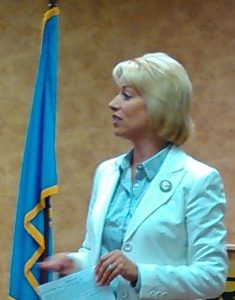Rocky de la Fuente is having a bad week. On Tuesday, the Florida businessman lost his U.S. Senate Democratic primary, placing a Bosworthian fourth behind winner Patrick Murphy and runners-up Alan Grayson and Pam Keith (but beating Reginald Luster 4.50% to 3.62%). Then Wednesday, de la Fuente lost his lawsuit to gain a place on South Dakota’s Presidential ballot.
De la Fuente sued Secretary of State Shantel Krebs and her deputy Kea Warne last week for rejecting his independent nomination petition. Based on the statutory 5% random sample, Secretary Krebs found only 61.1% of his petition signatures were valid, leaving him with 244 too few signatures to qualify for the ballot. De la Fuente contended that enough signatures in the sample were disqualified on unconstitutional grounds that he deserved placement on the ballot.

Ballot access watchdog Richard Winger reports that U.S. Judge Roberto Lange rejected de la Fuente’s arguments that requiring notary seals on nominating petitions is an unconstitutional burden on candidates. Losing that argument alone prevented de la Fuente from putting back enough signatures to qualify. Judge Lange also supported Secretary Krebs’s rejection of photocopied signatures on de la Fuente’s petition.
Winger reported that Judge Lange did accept de la Fuente’s argument that voters signing petitions should not have to report their county of registration. However, in our conversation at lunch today, Secretary Krebs reported that Winger is mistaken: Judge Lange, finding enough other reasons to invalidate de la Fuente’s petition, did not address the county question in his ruling from the bench or his written order. Secretary Krebs did say that the Board of Elections is considering petition reforms and that among their discussions will be the question of just what information is necessary on modern petitions, but for now, petitioners, keep getting counties!
In responding to de la Fuente’s challenge, the state noticed that de la Fuente’s petition was even more deficient than Secretary Krebs had first thought. Upon the review prompted by de la Fuente’s lawsuit, Secretary Krebs found four more signatures in the random sample that had been marked invalid but were not counted in the final math. That drops de la Fuente’s invalid signature rate to 59.1%. To have won his lawsuit, he would have had to win all of the arguments he was making about the 18 invalid signatures he was contesting, not just a lucky couple.

Worse, de la Fuente failed to satisfy a whole nother election requirement: SDCL 12-7-7‘s requirement that independent Presidential candidates “file a declaration of candidacy and a certification of the candidate’s selection for Vice President with the secretary of state prior to circulation of the candidate’s nominating petitions.” De la Fuente submitted his declaration of candidacy on August 1, the same day he submitted his petition, which means he circulated his petition before filing his declaration. He could win back every invalid signature and be disqualified entirely for failing to submit that declaration before circulating his petition.
Winger reports that de la Fuente is “likely” to amend his complaint to challenge South Dakota’s ban on out-of-state circulators. However, given that Secretary Krebs rejected no signatures based on the residence of de la Fuente’s circulators, a favorable verdict might shake up South Dakota’s petition laws (and open the door for more untrustworthy interstate mercenaries to come foul our petitioning), it would not put de la Fuente on the ballot.
Secretary Krebs faced three lawsuits in August over her decisions on petitions—the IM 21 36% rate cap petition, the medical cannabis petition, and de la Fuente’s nominating petitions. Secretary Krebs won each one.
Yo Adrian, I lost another fight!